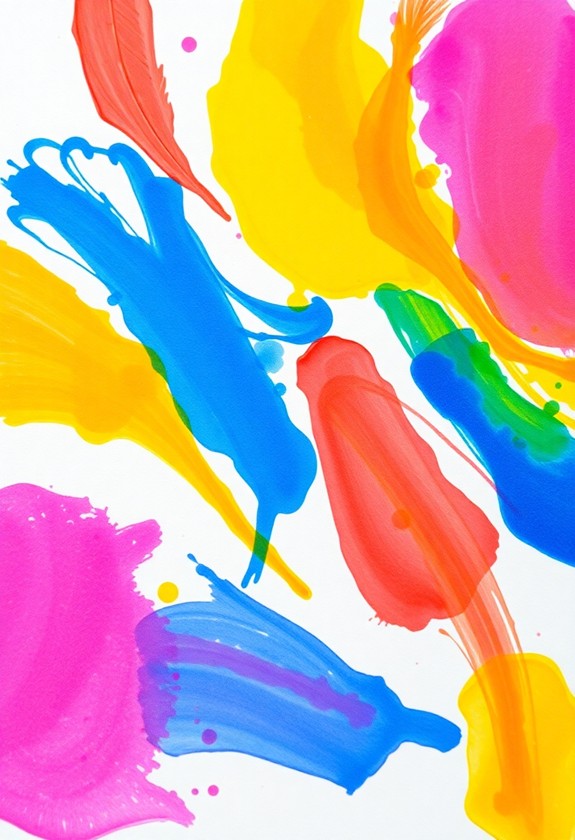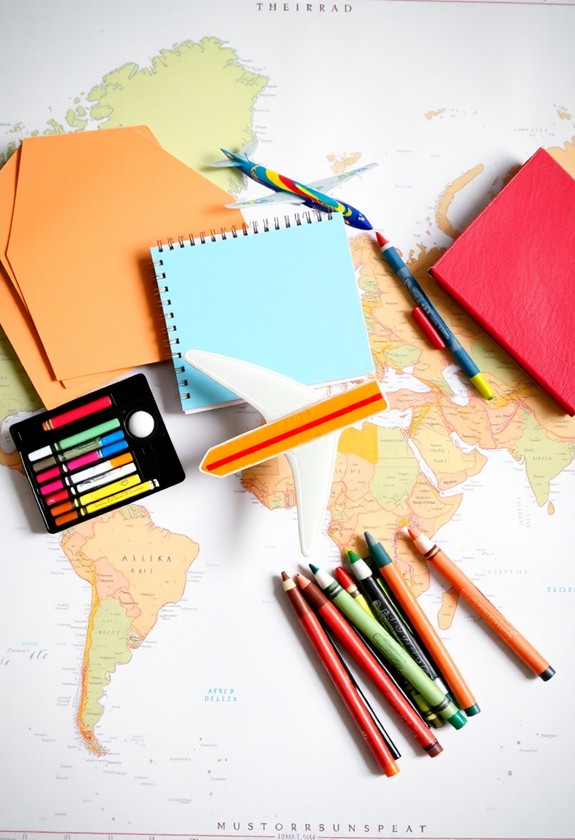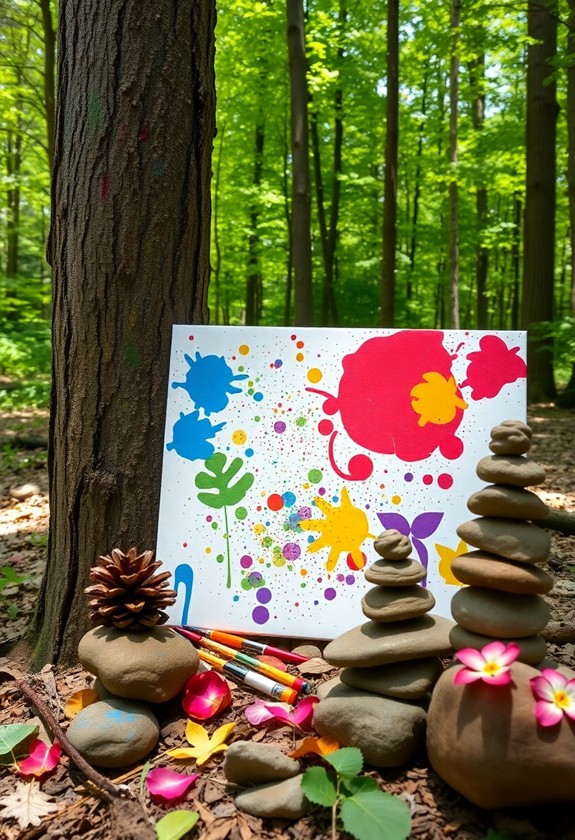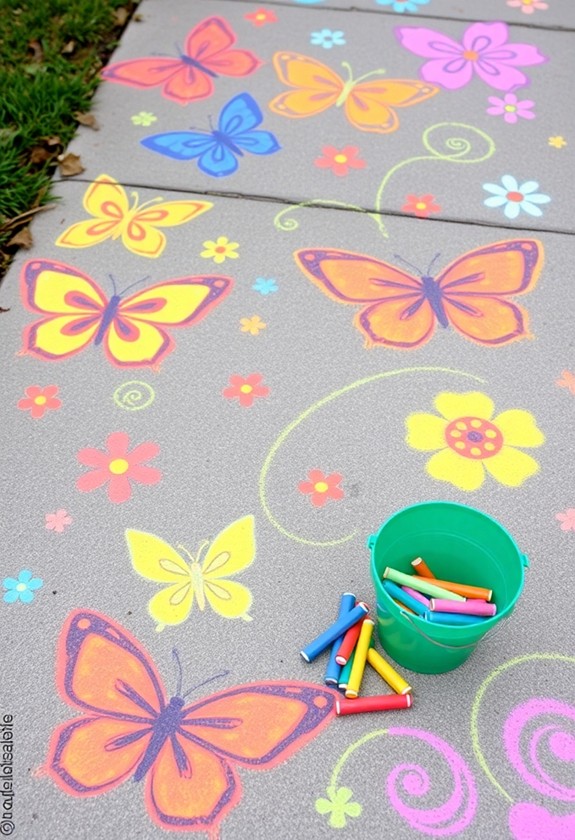Unleash your little adventurer's creativity with these five sensory art activities! Start with edible finger painting, where they can taste their masterpieces. Next, head outdoors for nature texture rubbings, capturing the world's textures on paper. Whip up some scented play dough for aromatic sculpting fun. Then, transform bubble wrap into a stamping tool for colorful patterns. Finally, delve into a sensory bin filled with art supplies for a tactile adventure! These activities engage multiple senses, develop fine motor skills, and spark imagination. But wait, there's more to uncover about each exciting artistic expedition!
Creative Highlights
- Edible finger painting promotes creativity and fine motor skills using safe, non-toxic materials like yogurt or pudding.
- Nature texture rubbings encourage outdoor exploration and tactile learning through crayon rubbings of various natural objects.
- Scented play dough sculptures combine olfactory and tactile senses, fostering creativity with aromatic homemade dough.
- Bubble wrap stamping transforms packaging material into a creative tool for exploring patterns, textures, and color mixing.
- Sensory bin art exploration engages multiple senses through a variety of materials, encouraging creative problem-solving and tactile play.
Edible Finger Painting
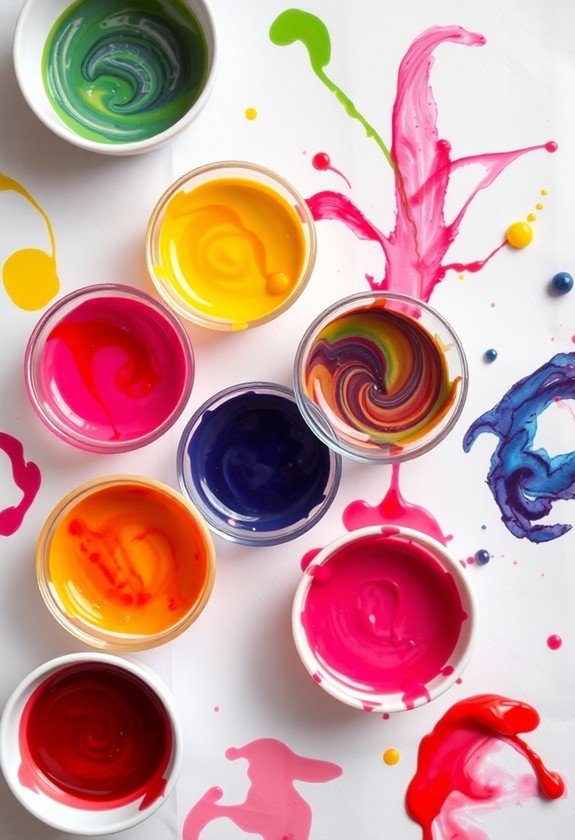
One of the most engaging sensory art activities for young children is edible finger painting. It's a messy, tasty adventure that'll have your little ones squealing with delight! This activity isn't just fun, it's also fantastic for developing fine motor skills and creativity. Using washable, non-toxic supplies like yogurt or pudding guarantees safety during promoting artistic expression.
What You'll Need:
- Yogurt or pudding (various colors)
- Food coloring
- Large paper or a tray
- Smocks or old clothes
Let's Get Painting!
First, mix different colors into your yogurt or pudding. Now, set out the colorful concoctions and watch your child's eyes light up! Encourage them to plunge right in, using their fingers to create swirls, dots, and handprints. They can even use their whole hand for a "palm-some" effect!
As they paint, ask them about the textures they feel. Is it smooth? Squishy? Cold? This sensory exploration is a feast for their fingers and their minds! And the best part? If they get a little hungry, it's perfectly safe to lick those fingers clean. It's truly art you can taste!
Nature Texture Rubbings
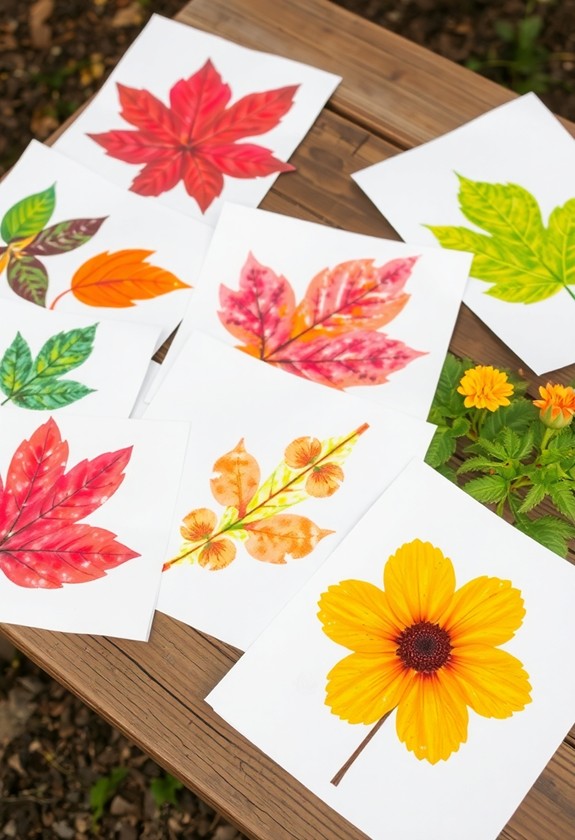
As edible finger painting offers a tasty sensory experience, nature texture rubbings take your little adventurers outdoors for a tactile adventure. Get ready to investigate the great outdoors and create amazing art! This activity is perfect for developing fine motor skills and imagination, much like the Horizon Group USA Bluey Aqua Art set, but with a natural twist.
What you'll need:
- Paper
- Crayons (with wrappers peeled off)
- Various natural objects
Head outside with your budding artists and let the fun begin! Encourage them to feel different textures – rough tree bark, smooth stones, or bumpy leaves. It's a texture treasure hunt!
Now for the magic! Place the paper over an interesting surface and rub the side of a crayon across it. Watch as patterns and textures appear like magic! Try different colors for each rubbing to create a lively collage.
But wait, there's more! Turn this into a guessing game. Can your little ones identify the object just by looking at the rubbing? It's like nature's own fingerprint!
This activity isn't just fun – it's educational too! It helps develop fine motor skills, improves observational abilities, and nurtures an appreciation for nature. So, grab those crayons and let's go on a texture adventure!
Scented Play Dough Sculptures
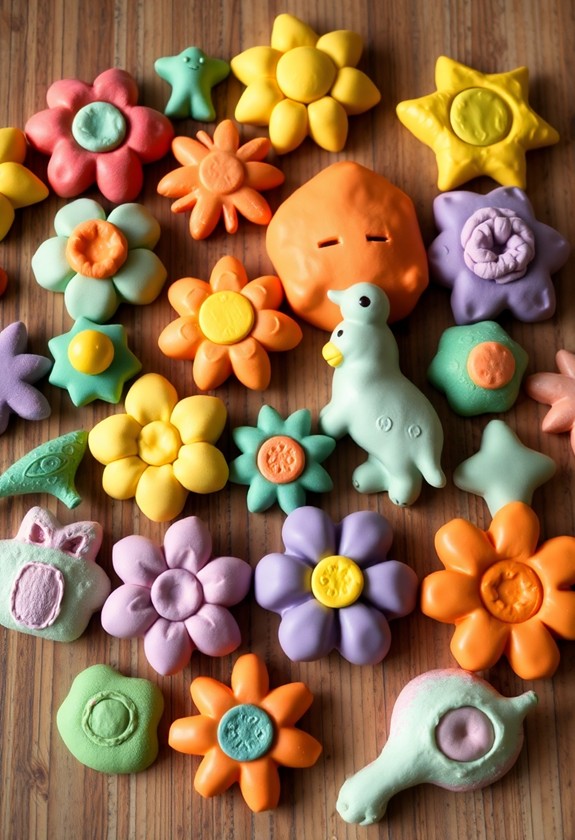
After examining nature's textures, it's time to engage your little one's sense of smell with scented play dough sculptures. This activity is a sensory delight that'll have your child squishing, molding, and sniffing their way to artistic bliss! For an extra burst of creativity, consider incorporating washable finger paints to add lively colors and textures to your child's sculptures, enhancing their sensory experience.
What you'll need:
- Homemade play dough
- key oils or food extracts
- Natural food coloring (optional)
Let's get started!
First, whip up a batch of homemade play dough. Now, here's where the fun begins! Add a few drops of your chosen scent to the dough and knead it in. Lavender for relaxation, peppermint for energy, or vanilla for a sweet treat – the options are endless!
Encourage your little sculptor to create anything their heart desires. They might craft a fragrant flower garden or a "scent-sational" zoo! As they work, ask them to describe the scents and how they make them feel. This activity isn't just nose-tastic fun, it's also great for developing fine motor skills and creativity.
Bubble Wrap Stamping

Ever wondered how to turn bubble wrap into a fun art tool? Get ready for some popping good fun with bubble wrap stamping! This activity is a blast for little artists and will have them giggling with delight. It's a safe and engaging craft that promotes creativity without the need for scissors, making it perfect for younger toddlers.
What you'll need:
- Bubble wrap
- Paint
- Paper
- Scissors
- Paint brushes
Let's get stamping!
- Cut the bubble wrap into manageable pieces.
- Dip your brush in paint and apply it to the bumpy side of the wrap.
- Press the painted bubble wrap onto paper – watch the magic happen!
The result? A bubbly masterpiece! Mix colors for a rainbow effect, or create patterns by rotating the wrap. Why not try making bubble wrap animals? A green frog or a blue fish would look toad-ally awesome!
But wait, there's more! Pop a few bubbles before stamping for varied textures. Or use the wrap as a rolling pin to create long, textured strips. The possibilities are endless!
This activity isn't just fun – it's great for developing fine motor skills and creativity. So, let's get popping and stamping! Your little adventurers will have a bubbling good time!
Sensory Bin Art Exploration
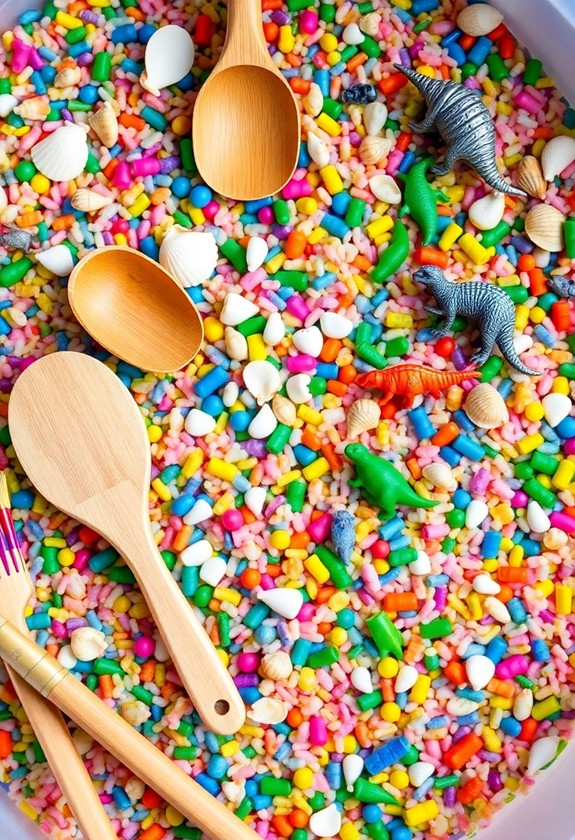
From bubble wrap to bins, let's examine another exciting sensory art adventure! Sensory bin art discovery is a fantastic way to engage your little one's senses during the creation of masterpieces. It's messy, it's fun, and it's oh-so-creative! This type of activity is particularly beneficial for brain development, as it provides multi-sensory experiences that aid in memory retention and information processing. Regular engagement in such crafts can stimulate brain regions associated with problem-solving and creativity.
What you'll need:
- A large, shallow container
- Various art materials (paint, glitter, beads, pom-poms)
- Paper or canvas
- Scoops, spoons, or small toys
Let's get started!
First, fill your bin with a mix of colorful, tactile materials. Think rainbow rice, kinetic sand, or even cooked spaghetti! Now, add some art supplies to the mix. Squirt in some paint, sprinkle glitter, or toss in some beads. It's time to let your little creator plunge into the fun!
Encourage your child to scoop, pour, and mix the materials. They can create patterns on paper by pressing painted objects onto it, or use their hands to make textured impressions. The possibilities are endless! And remember, it's not just about the final product – it's about the sensory expedition. So, get ready for a bin-credible art experience that'll have your little one begging for more!
Curious Little Questions
How Can I Adapt These Activities for Children With Sensory Sensitivities?
You can adapt activities for kids with sensory sensitivities by:
- Offering choices: Let them pick materials they're comfortable with.
- Going slow: Introduce new textures gradually.
- Creating a calm space: Reduce noise and bright lights.
- Using tools: Provide brushes or gloves for messy activities.
- Offering breaks: Allow time to decompress.
- Providing alternatives: Have non-tactile options available.
What Age Range Are These Sensory Art Activities Most Suitable For?
You'll find these sensory art activities are perfect for little ones aged 2 to 8! They're especially great for preschoolers and early elementary kids. But don't worry, you can easily adapt them for younger toddlers or older children too. The key is to keep it fun and age-appropriate. For the littlest artists, focus on simple textures and colors. For older kids, amp up the complexity and let their creativity soar! Remember, every child develops differently, so trust your instincts and let them investigate at their own pace.
Are There Any Safety Precautions to Consider When Doing These Activities?
Safety first, little artists! You'll want to keep a watchful eye on your adventurers during these fun activities. Always supervise closely, especially with small objects that could be choking hazards. Use non-toxic, washable materials that are safe if accidentally tasted. Watch out for scissors – kid-friendly ones are best! And don't forget to protect clothes and surfaces with smocks and drop cloths. Remember, messy is fun, but safe is essential! With these precautions, you're all set for a fantastic, worry-free creative adventure!
How Can I Incorporate Learning Objectives Into These Sensory Art Experiences?
You can make learning a blast with sensory art! Mix colors to teach basic science, count objects for math skills, or investigate textures to boost vocabulary. Why not create shapes with playdough for geometry fun? Or try finger painting letters for early literacy! Don't forget to chat about the process – it's a great way to develop language skills. Remember, learning through play is the way! Your little artists will be soaking up knowledge without even realizing it. How cool is that?
What Are Some Ways to Display or Preserve the Artwork Created?
Like a gallery of colorful treasures, your little one's artwork deserves to shine! Create a special display wall in your home, using clothespins on strings for an ever-changing exhibit. Or, make a scrapbook to preserve memories. You can even snap photos of 3D creations and compile them into a digital album. For extra flair, try framing standout pieces or creating a rotating "Artist of the Month" showcase. Don't forget to label each masterpiece with the date and artist's name!

